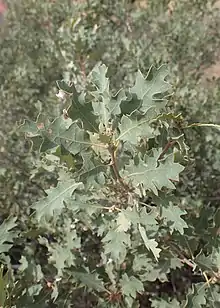Quercus welshii
Quercus welshii, the wavy leaf oak, shinnery oak, or Tucker oak, is a North American species of shrub in the (beech family) found in the Colorado Plateau and Canyonlands region of the southwestern United States.[3]: 143
| Quercus welshii | |
|---|---|
 | |
| Scientific classification | |
| Kingdom: | Plantae |
| Clade: | Tracheophytes |
| Clade: | Angiosperms |
| Clade: | Eudicots |
| Clade: | Rosids |
| Order: | Fagales |
| Family: | Fagaceae |
| Genus: | Quercus |
| Subgenus: | Quercus subg. Quercus |
| Section: | Quercus sect. Quercus |
| Species: | Q. welshii |
| Binomial name | |
| Quercus welshii R.A.Denham | |
| Synonyms[1][2] | |
| |
Description
Roots, stems, and leaves
The plant has an elaborate root system, anchoring it in sandy soils and helping stabilize soils in sandy desert scrub communities.[3]: 143
The leaves are elliptical or lance-shaped with 6–10 lobes along the margins and pointed tips, sometimes with lobes and teeth.[3]: 143
The leaves are up to 1⁄2 to 2 in (1.3 to 5.1 cm) long with dense hairs on both sides, becoming smooth with age.[3]: 143
Taxonomy
The species was first described by Stanley Larson Welsh in 1986 as Quercus havardii var. tuckeri. It was raised to a full species by R.A. Denham in 2003 using the replacement name Quercus welshii,[4] named after Welsh,[3]: 143 as the name Quercus tuckeri had already been used for a fossil species.[5] Quercus welshii has been included within Quercus havardii, but both morphological and molecular evidence suggests that it is distinct.[6] Quercus welshii is not included in a 2017 list of Quercus species by subgenus and section, but Quercus havardii is placed in Quercus sect. Quercus.[7]
Distribution and habitat
Quercus welshii can be found in sand desert shrub communities, and sandy soils of blackbrush scrub and pinyon–juniper woodland communities in Arizona, Utah, western Colorado, and northwestern New Mexico.[3]: 143 [8]
References
- "Quercus welshii R.A.Denham", World Checklist of Selected Plant Families, Royal Botanic Gardens, Kew, retrieved 5 September 2014 – via The Plant List Note that this website has been superseded by World Flora Online
- "Quercus welshii", International Plant Names Index (IPNI), Royal Botanic Gardens, Kew; Harvard University Herbaria & Libraries; Australian National Botanic Gardens
- Canyon Country Wildflowers, Damian Fagan, 2nd ed., 2012, Morris Bush Publishing, LLC. in cooperation with Canyonlands Natural History Association, ISBN 978-0-7627-7013-7
- "Quercus welshii R.A.Denham". The International Plant Names Index. Retrieved 2023-03-02.
- "Quercus tuckeri". The International Fossil Plant Names Index. Retrieved 2023-03-02.
- Zumwalde, Bethany A.; McCauley, Ross A.; Fullinwider, Ian J.; Duckett, Drew; Spence, Emma & Hoban, Sean (2021). "Genetic, Morphological, and Environmental Differentiation of an Arid-Adapted Oak with a Disjunct Distribution". Forests. 12: 465. doi:10.3390/f12040465.
- Denk, Thomas; Grimm, Guido W.; Manos, Paul S.; Deng, Min & Hipp, Andrew L. (2017-11-02). "Appendix 2.1: An updated infrageneric classification of the oaks" (xls). figshare. Retrieved 2023-02-17.
- "Quercus welshii", County-level distribution map from the North American Plant Atlas (NAPA), Biota of North America Program (BONAP), 2014